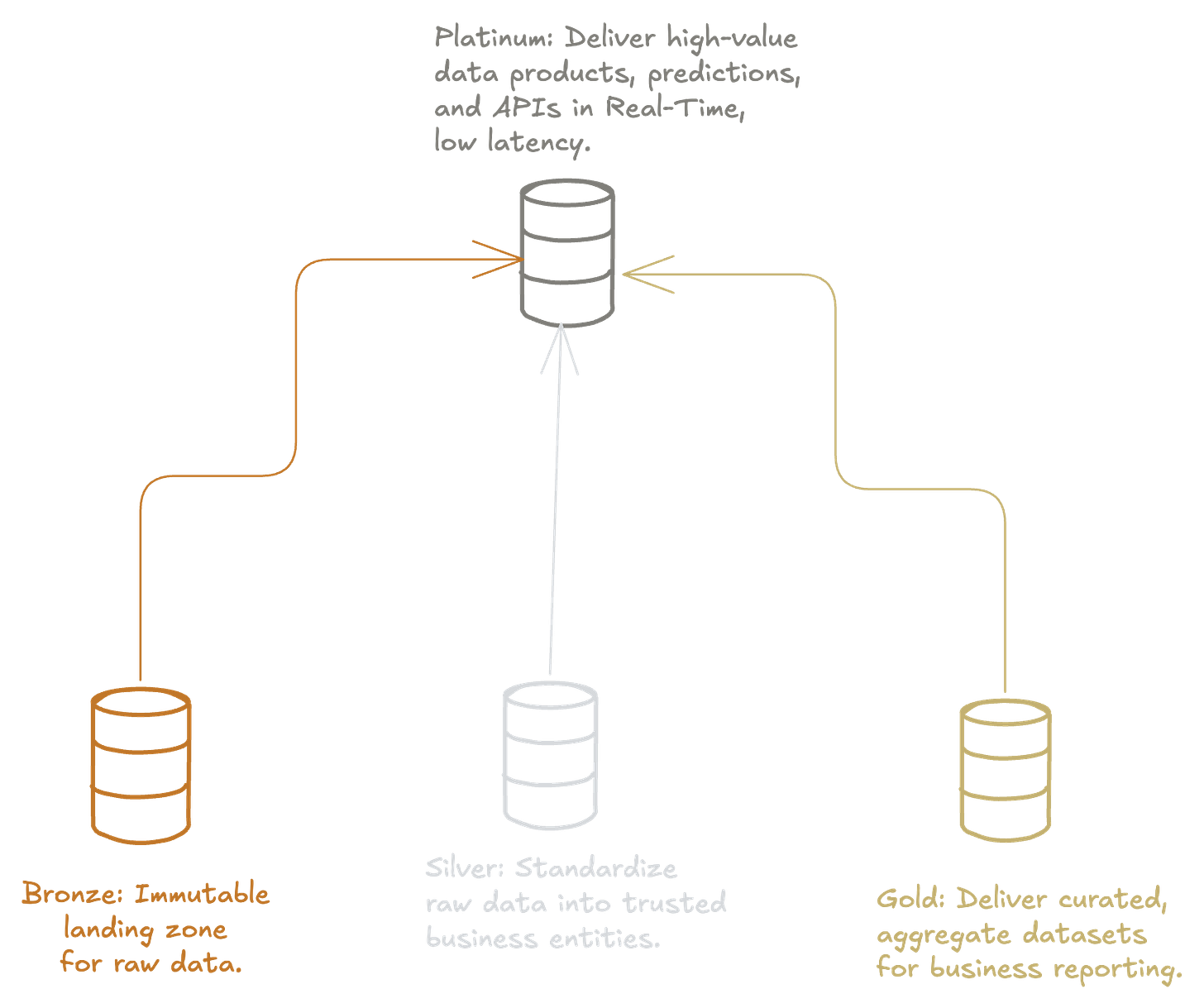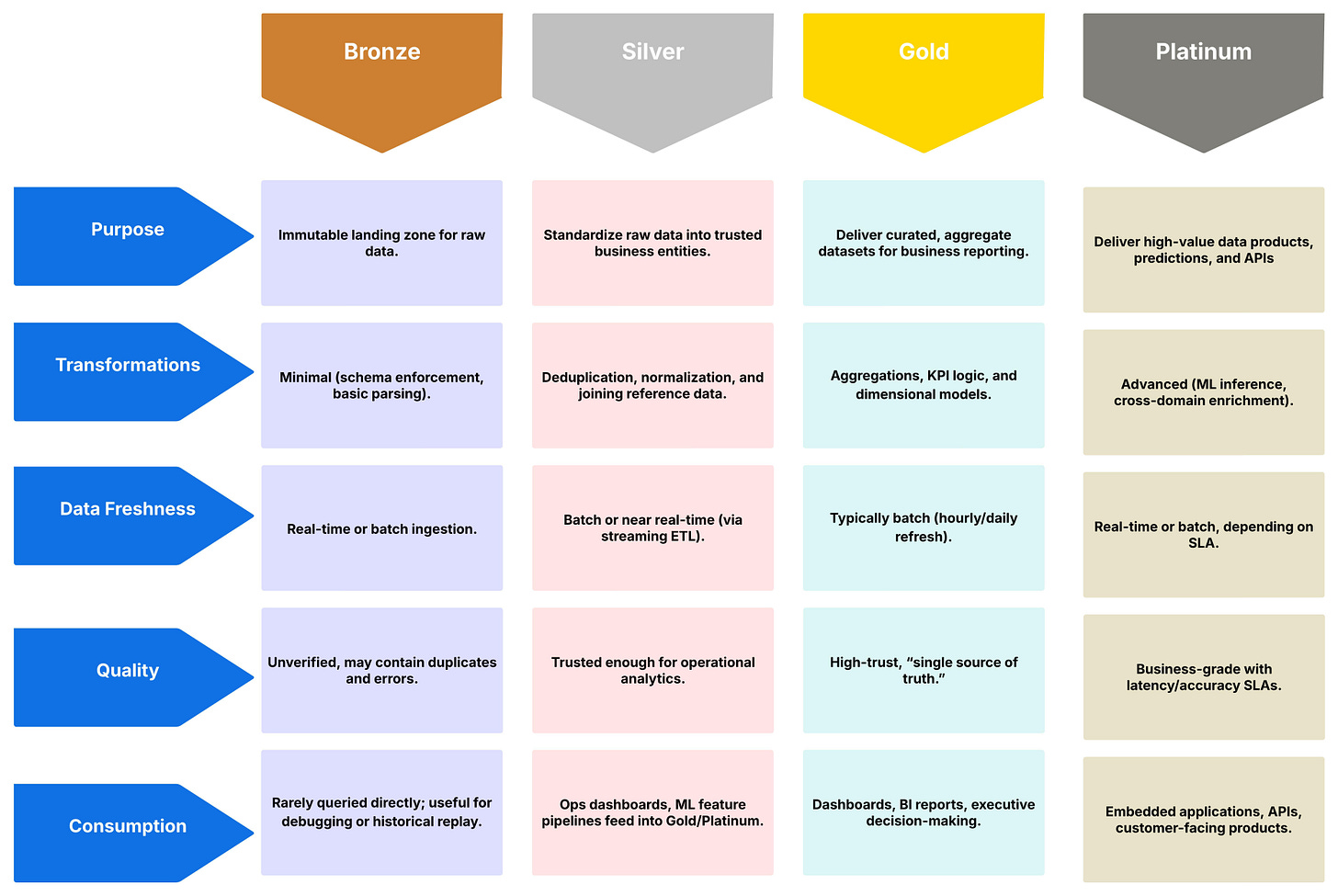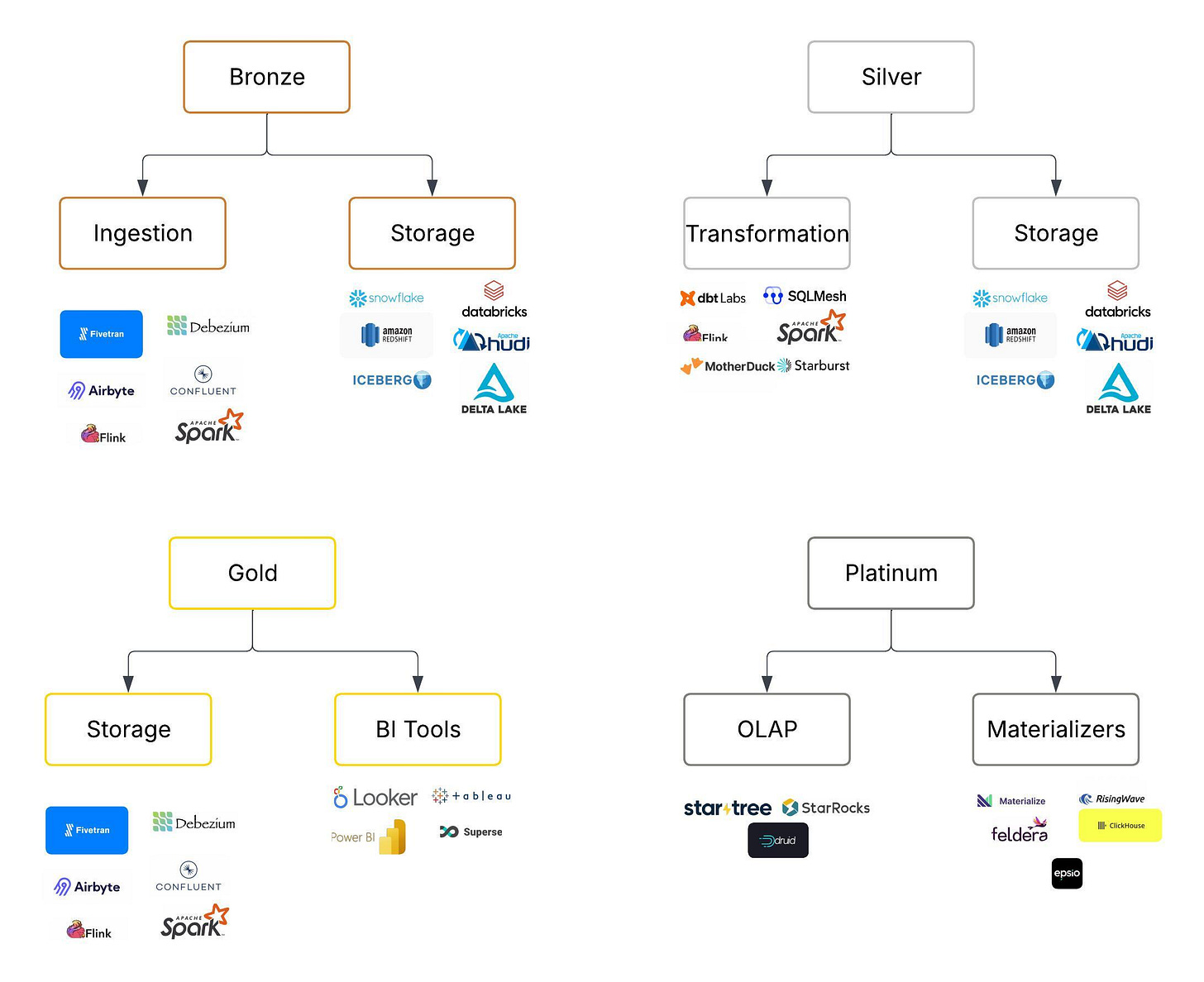Revisiting Medallion Architecture
The Evolution and Context of the Medallion Architecture
Every modern data team faces the same problem: how to turn messy, raw data into something trustworthy and usable. The Medallion Architecture offers one answer. Coined and popularized primarily through the rise of Databricks and the lakehouse movement, it has provided a simple yet powerful mental model for structuring data pipelines in a way that balances raw ingestion, incremental refinement, and curated business outcomes. The architecture typically organizes data into three distinct layers: Bronze, Silver, and Gold.
Bronze is raw. Silver is refined. Gold is curated. Together, they turn chaos into clarity. The intuitive naming convention—Bronze to Gold—offers a tiered approach to data trust and usability, similar to how medals represent achievement levels in sports.
That said, the naming has always felt odd to me. "Bronze, Silver, Gold" works well enough as a mnemonic, but data architecture is not a medal competition. Data engineering is about building durable, scalable, and understandable systems. However, despite my initial reservations about the naming, I have come to appreciate the value of a bounded definition. Medallion Architecture gives teams a shared vocabulary. When someone says, “That dataset is in Silver,” everyone understands its level of trust, transformation, and purpose. This bounded language has made it easier for teams across engineering, analytics, and business functions to align around expectations.
In practice, organizations have actively embraced the Medallion approach. From startups building their first lakehouse to enterprises modernizing their legacy data warehouses, the model provides a conceptual scaffolding that lowers the barrier to collaboration. It provides engineers with a path to refine data incrementally, while also giving business users confidence that the data they consume carries certain guarantees. It is precisely because of this simplicity that the Medallion Architecture has endured as a useful organizing principle.
Still, as we see companies adopt this architecture at scale, new needs and ambiguities emerge. Not every analytics workload fits neatly into batch-oriented, layered pipelines. Not every use case tolerates the latency of waiting for Gold transformations. The very nature of online analytics makes it essential to extend the architecture with operational analytics and a Platinum layer.
Operational Analytics vs. Business Analytics
One of the clearest lessons from the last decade of data infrastructure is that analytics is not a monolithic entity. Organizations succeed when they blend different types of analytics into a cohesive ecosystem. Two categories stand out: Operational Analytics and Business Analytics.
Business Analytics is what most people imagine when they think of analytics. It involves curating historical data into aggregates, dashboards, and reports that inform strategic decision-making. Executives examine quarterly revenue trends, product managers analyze churn over the past year, and finance teams prepare forecasts. Business Analytics thrives on trusted, curated data—often refreshed daily or hourly—and prioritizes consistency over immediacy.
Operational Analytics, by contrast, is about enabling frontline teams to act in real-time or near real-time. It asks questions like: “Which shipments are experiencing delays right now?” or “Which customers are most likely to churn this week?” It powers marketing campaigns that respond instantly to customer behavior, fraud detection systems that act within seconds, and DevOps alerts that prevent outages before they cascade. Operational Analytics prioritizes freshness and speed, often at the expense of full historical depth.
Both are critical. Business Analytics ensures strategic alignment; Operational Analytics ensures tactical agility. Without business analytics, organizations lose sight of long-term trends. Without operational analytics, organizations fail to adapt to moment-to-moment realities. The challenge—and opportunity—for modern data architecture is to blend these two modes seamlessly.
The operational analytics is where the Medallion Architecture begins to stretch its limits. Bronze and Silver provide the raw and cleaned data needed for operational decision-making. Gold delivers the trusted aggregates for business analytics. But we need an additional layer that harmonizes both—one that can serve predictive models, real-time personalization, and premium data products. The tension between operational and business analytics is exactly why the Medallion model needs an extension: Platinum Layer.
The Platinum Layer
Platinum isn’t just “more Gold.” It’s an action. It’s speed. It’s intelligence embedded directly into products. Platinum powers embedded intelligence and decision systems. It represents the culmination of both operational and business analytics.
Key Characteristics of Platinum
Low Latency: Platinum datasets tuned for real-time or near real-time consumption. They often drive APIs or applications that cannot wait for batch pipelines.
Advanced Transformations: Platinum includes predictive models, machine learning features, and cross-domain aggregations that require both operational freshness and historical context.
Premium Consumers: Whereas Gold caters to analysts and executives, Platinum caters to applications, ML models, and sometimes external customers. It is data that actively drives product functionality or business workflows.
Multiple Entry Points: Platinum is not always sequential. It may consume directly from Bronze (raw events for real-time fraud detection), from Silver (cleaned entities for personalization), or from Gold (historical aggregates for batch ML inference). It is best thought of as a serving hub rather than just the final stop.
In short, Platinum is where data stops being passive and becomes an accelerator. It is the layer where data engineers and machine learning engineers collaborate most closely, and where business teams see the most immediate impact.
Core Characteristics of Each Layer
Let’s revisit each layer of the Medallion Architecture with a crisp set of core characteristics:
Bronze Layer
The Bronze layer is the foundation of the Medallion Architecture, where raw data first lands. Its defining characteristic is immutability—this layer acts as a system of record for every event, log, or transaction ingested. Transformations are minimal, often limited to schema enforcement or basic parsing. Because the data arrives in its most raw and unverified state, it may contain errors, duplicates, or inconsistencies. Consumption from this layer is rare, reserved for debugging, reprocessing, or forensic analysis. By recognizing Bronze as the lowest-trust zone, engineers can design pipelines that prioritize reliability and traceability, ensuring nothing is lost while keeping downstream systems insulated from noise.
Silver Layer
The Silver layer takes raw inputs and molds them into trusted, standardized entities. Here, transformations like deduplication, normalization, and reference data joins ensure that customers, products, and transactions can be reliably linked across domains. Data freshness often comes from batch or near-real-time pipelines, giving operational teams access to clean information quickly. This makes Silver ideal for operational analytics and as a staging ground for both Gold and Platinum. Understanding Silver’s role helps teams design robust conformance processes that balance latency with quality, ensuring that downstream layers inherit a stable foundation.
Gold Layer
The Gold layer represents the single source of truth for business reporting. Its purpose is to deliver curated, aggregated datasets that encode KPI logic and business definitions. Transformations at this stage are heavier, involving dimensional modeling, aggregations, and semantic alignment. Because the emphasis is on consistency, Gold often refreshes on hourly or daily cadences rather than second-by-second updates. Analysts and executives consume Gold to answer strategic questions and align the business around a common view of performance. By clearly defining Gold’s characteristics, teams can avoid confusion between exploratory data and authoritative data, reducing conflicts and duplication of effort.
Platinum Layer
The Platinum layer extends the architecture into premium, action-oriented data products. Unlike Gold, which focuses on batch-curated insights, Platinum emphasizes speed and direct application embedding. Whether it’s an ML inference model serving fraud detection in real time or an API delivering customer personalization, Platinum is about turning data into a business accelerator. Transformations may combine live event streams with historical context, requiring both low latency and high accuracy—consumption shifts from BI tools to applications, APIs, and customer-facing products. Recognizing Platinum’s characteristics helps organizations design infrastructure that supports not just reporting, but also automation, personalization, and monetization.
By internalizing the characteristics of each layer, architects can design infrastructure that is fit for purpose at every stage—from raw ingestion to curated reporting to real-time intelligence. This clarity prevents misuse (e.g., treating Silver as Gold), improves governance, and enables teams to align infrastructure investments with the needs of both operational and business analytics.
Pitfalls of Misusing Layers
1. Bronze Misuse – Treating Raw as Ready
It’s tempting. It’s dangerous. Dashboards break, trust erodes. Because this data is unverified and often messy, it leads to inconsistent results, duplicate counts, and mistrust. Bronze should act as a historical record, not a source of truth. Teams that skip Silver and Gold risk embedding bad data into reports or models, which undermines confidence in the entire data platform.
2. Silver Overload – Turning It Into Gold
The Silver layer is designed for conformance, not final reporting. A pitfall occurs when teams start building business KPIs and heavy aggregations directly in Silver tables. This creates semantic sprawl—different teams define metrics differently, and there is no single authoritative version. By keeping Silver focused on entity standardization and leaving metric definition to Gold, organizations maintain clarity and governance.
3. Gold Latency Expectations – Forcing Real-Time Use Cases
Gold’s strength lies in curated, batch-refreshed aggregates. Problems arise when organizations expect Gold to deliver real-time analytics. Attempting to retrofit Gold for low-latency workloads often introduces brittle pipelines, performance bottlenecks, and spiraling costs. Instead, real-time decisioning should be handled in Platinum, where systems are built with low-latency SLAs in mind.
4. Platinum Confusion – Treating It as “Just Another Gold”
Some teams misinterpret Platinum as simply “more Gold.” This misses its essence: Platinum is about data products and embedded intelligence, not just another reporting layer. Using Platinum solely for curated batch aggregates adds little value and wastes infrastructure. Platinum should be reserved for use cases like ML features, real-time personalization, APIs, and monetizable datasets. Treating it correctly ensures data drives actions, not just reports.
5. Cross-Layer Entanglement
Another pitfall is when data pipelines leak responsibilities across layers. For example, ingesting raw events directly into Gold, or having Platinum pipelines depend on unrefined Bronze data. This entanglement creates fragile systems where a schema change or ingestion hiccup cascades across the stack. Clear boundaries between layers—each with defined guarantees—protect against systemic failures.
Misunderstanding or blurring layer boundaries leads to unreliable analytics, duplication of logic, and wasted resources. By respecting each layer’s purpose, transformations, freshness, quality, and consumption model, organizations build infrastructure that is not only more scalable but also more trustworthy.
Tools and Vendors by Layer
The Medallion Architecture is conceptually vendor-agnostic, but in practice, certain tools dominate specific layers. Below is an extended mapping that reflects today’s market landscape.
Conclusion
The Medallion Architecture remains one of the most useful frameworks in data engineering. Despite some quirks in its naming, its bounded definitions have given teams a common language to structure data systems.
In embracing Platinum, organizations don’t just refine their data—they redefine how data drives decision-making.
Bronze captures. Silver cleans. Gold defines. Platinum accelerates. Together, they’re not just a pipeline—they’re a blueprint for intelligence. Tools and vendors have emerged across each layer, making it easier than ever for teams to implement.
In revisiting the Medallion Architecture, we see not just a three-tiered model, but a living blueprint. One that evolves to capture both the timeless needs of business analytics and the urgent demands of operational analytics. One that positions data not just as a record of what happened, but as a driver of what happens next.





We talk about the “tin layer” in Delta Lake: The Definitive Guide. It’s for landing zone, pre-bronze data. Essentially where things land before being converted to Delta (or really Iceberg or any future table format)
Is not this feature store